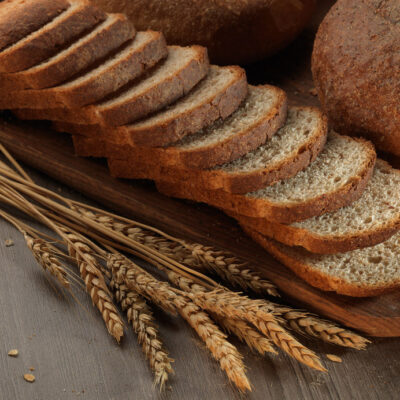How is it made?
The best way to make a good loaf of whole wheat bread is by using the sponge and dough. This allows for enzymes and yeast to work on the flour components, and improve the properties of dough, texture, flavor and digestibility of the finished product.
Formulation
Sponge (80% pre-fermentation of flour):
| Ingredients | Baker’s % (based on flour weight) |
| Whole wheat flour* | 80.0 |
| Water | 56.0 |
| Yeast (compressed) | 1.5** |
| Vital wheat gluten | 4.0 |
| Total | 141.5 |
*Milled from hard red spring (HRS), hard red winter (HRW). Hard white can be used but color, aroma and flavor will not be the same as with red wheat.
**Yeast amount for an 8-hour sponge fermentation.
Dough formulation (72% total hydration):
| Ingredients | Baker’s % |
| Whole wheat flour | 20.0 |
| Water | 16.0 |
| Yeast (compressed) | 2.5 |
| Salt | 2.2 |
| Sugar (sucrose) | 5.0 |
| Honey | 5.0 |
| Butter (unsalted) | 5.0 |
| Ascorbic acid | 120 ppm |
| Clean label enzyme blend | 0.4 |
| Raisin juice concentrate | 2.5 |
| Sponge | 141.5 |
| Total | 196.7 |
Processing
- Ingredient scaling/metering.
- Sponge preparation.
- Sponge mixing: mix ingredients at low speed for 2–3 minutes just to incorporate the ingredients.
- Sponge fermentation: ferment sponge for 8 hours at room conditions. TTA, pH and temperature require monitoring.
- Dough mixing: incorporate dough ingredients and sponge at low speed for 2 min. Then, continue mixing at high speed to full gluten development. This usually takes 8–12 minutes.
- Floor time: allow dough to rest for 15 minutes.
- Makeup.
- Dividing.
- Rounding.
- Intermediate proofing.
- Sheeting and moulding.
- Panning.
- Final proofing: proof to full height at 92–95°F (33–35°C), 75–80% RH. Usually takes 45–60 minutes.
- Baking: bake at oven temperatures of 380–420°F (193–215°C) to an internal temperature of 204°F (95°C). Thermal profiling is recommended for proper control and optimum quality. Bake time is usually longer than white pan bread.
- Cooling: cool loaves to an internal temperature of 90–95°F (32–35°C); usually takes 1–2 hours.
- Packaging
Nutrition
Nutrient content of whole wheat flour:2,3
| Nutrient | % (g/100 g) |
| Moisture | 12.0 |
| Protein | 13.0 |
| Total lipids | 2.5 |
| Carbohydrates (80% starch) | 70.0 |
| Total sugars | 0.5 |
| Dietary fiber* | 10.2 |
| Ash | 1.5 |
| Calcium | 35.0 (mg/100 g) |
| Potassium | 360.0 (mg/100 g) |
| Magnesium | 137.0 (mg/100 g) |
| Phosphorous | 357.0 (mg/100 g) |
| Folate | 42.0 (mg/100 g) |
| Niacin | 5.0 (mg/100 g) |
| Vitamin A | 9.0 (mg/100 g) |
| Phytic acid** | 740.0 (mg/100 g) |
* Comprised of non-starch polysaccharides and cell wall components: arabinoxylan (AX), β-glucan and cellulose
** White all-purpose flour has 83 mg phytic acid/100 g.
Application
Water absorption of whole wheat bread doughs is higher than regular white pan bread due to the presence of bran and vital wheat gluten, which is added to compensate for the dilution of gluten proteins.
Whole wheat bread dough has a lower mixing stability and less tolerance to overmixing. This is due to the presence of bran particles that partially disrupt or cut the gluten network. As a result, colder dough temperatures and shorter mixing times than those with white bread are recommended
Whole wheat doughs are stiff and tight, and lack enough elasticity and resistance to deformation. For this reason, bakers should apply gentle stresses and lower pressures during rounding, sheeting and moulding to preserve gas bubble structure and prevent dumbbelling. They are also less sticky than regular white bread doughs, so little dusting flour is needed during makeup.
FDA regulation
Whole wheat bread is a standardized food product according to CFR Title 21 Part 135.4 According to the Standard of Identity, whole wheat bread can only use flour from whole wheat.
References
- Finnie, S., and Atwell, W.A. Wheat Flour, 2nd edition, Ingredient Handbook Series, AACC International, Inc., 2016, pp. 1–159.
- Finnie, S., and Atwell, W.A. Wheat Flour, 2nd edition, Ingredient Handbook Series, AACC International, Inc., 2016, pp. 1–159.
- King, D.L., Jasthi, B., and Pettit, J. “Composition of Grains and Grain Products.” Cereal Grains. Assessing and Managing Quality, 2nd Edition, Woodhead Publishing, Elsevier Ltd., 2017, pp. 727–750.
- U.S. Food and Drug Administration. “21 CFR 136 – Bakery Products.” April 1 2018, https://www.accessdata.fda.gov/scripts/cdrh/cfdocs/cfcfr/CFRSearch.cfm?CFRPart=136. Accessed 9 June 2019.

